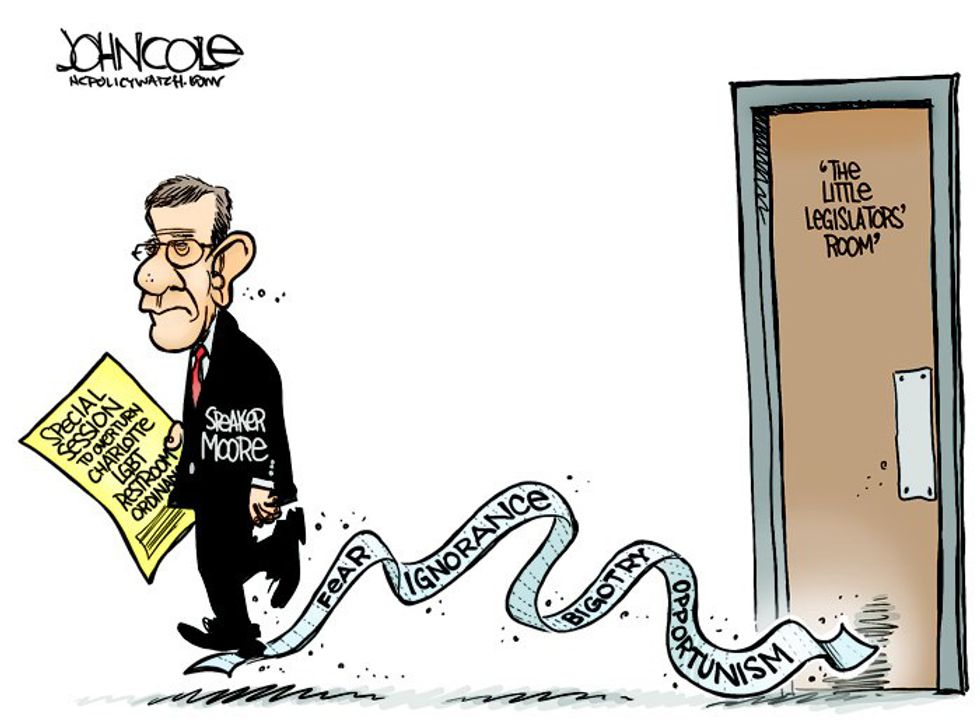With the onset of LGBT+ rights movement in recent years, vocal resistance to the movement and other related issues is at an all-time high. Currently, transgender rights are at the forefront of the conversation. Various legal measures aimed at maintaining a conservative idea of gender have made their way into many state legislatures and may, such as with North Carolina's HB2 legislation, become law.
These bills not only aim to define gender as one's natal
The discussion and implications of HB2 highlight two vital issues: the disapproval of transgender individuals in modern society, and the prominence of rape culture, specifically as it affects women. Not only is it a waste of time to connect these two otherwise unrelated societal issues, but it is ludicrous to infringe upon the rights of transgender individuals, and defend this injustice with society's inability to properly condemn sexual harassment/assault. Often, proponents of this bill argue the importance of keeping men out of women's bathrooms, saying that without the bill, any man will be able to enter a women's bathroom at will.
Transgender men and women already have a difficult time acclimating in society. Some studies have found that transgender individuals have a significantly higher suicide rate than the general population; anywhere from 16 percent to 33 percent of transgender men and women claim to attempt suicide sometime in their life. Not only that, but hormone treatments and corrective surgeries can be exorbitantly priced, and are not covered by all insurance plans. While there are people who believe that non-traditional gender identities are a choice, there is scientific evidence to support claims that it is inborn. In one specific study of male-to-female transgender women, it was shown that the brains of pre-transitional transgender women more closely matched that of their gender identity than that of their natal sex, and hormone treatments further “shape” the brain's framework to match their gender identity. While the scientific community is slowly progressing to the consensus that transgenderism is inborn, there is still heavy resistance among the general community to identify non-traditional gender identities as anything other than a choice or a perversion. Although it is more common to hear about cases of trans men and women in modern media than in years past, transgender individuals have always been present in the general populace, either openly or closeted. Why, then, is there such a recent concern as to the bathroom habits of these people?
Coincidentally, the push to pass legal restraints such as HB2 on bathroom use and gender identity is occurring in the midst of a progressive movement to understand gender and its many complexities. The socially conservative agenda has always opposed transgender rights, and this bill represents a last-ditch effort to undermine the progress made on trans rights in the name of “public safety”. Worst of all, arguments for this bill cite yet another issue the socially conservative agenda fails to address: rape culture.
Almost every argument in support of HB2 singles out the safety of females in the women’s bathroom, and the hazards they may face if dangerous men are allowed to enter women’s bathrooms. Proponents of these arguments, however, fail to apply the same logic to the safety of male children and adults in men’s bathrooms. This bill represents a societal accommodation to rape culture rather than a solution to the prominence of rape. Rather than take steps as a society to create a culture where offenders are held responsible for their actions, lawmakers choose to create environments of safety from expected perpetrators. In the defense of the opposition, however, men are statistically most likely to be perpetrators of sexual violence. According to the 2010 National Intimate Partner and Sexual Violence Survey completed by the Centers for Disease Control and Prevention, victims of sexual violence, both men and women, primarily experience this violence from men. Female survivors of sexual violence note male perpetrators 98.1% of the time, and for male survivors, 93 percent of the perpetrators are men as well (a surprising number of identified male-to-male sexual offenders actually identify as heterosexual). These same men currently use men’s bathrooms, yet the safety of sons and husbands is not called into question nearly as often as daughters and wives.
If society would like to put an end to the prominence of rape, then it should begin to hold rapists accountable for their actions. Only about 10% of reported rape cases actually end in a sexual assault charge, and many cases aren’t reported to the police because victims often fear for their safety and wellbeing. The justice system is broken in its capacity to defend victims of sexual assault. Saving our women and children seems like a noble cause in order to protect the passage of laws like HB2, but throwing trans people into the crosshairs of an unrelated battle is not a viable solution to the issue of rape culture. If a sex offender wants to break the law, bills like HB2 are not going to stop anything. Sex offenders are criminals, and HB2 is yet another law they can break.
HB2 is not about protecting public safety, but it’s about discrimination. It is an example of passing legal constraints to give close-minded members of the population some closure on a topic they do not understand. Legal constraints on individuals based on inborn traits are discriminatory. It is critical to understand HB2 for what it is. Society cannot allow any general misunderstanding of transgender men and women to affect the everyday lives of these people, and moreover, society cannot allow this same misunderstanding to turn trans people into scapegoats for an issue they have not caused.

























